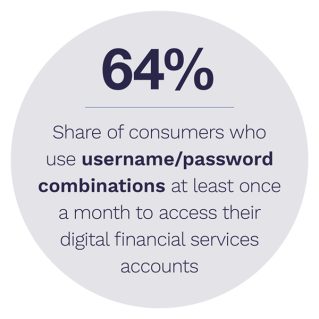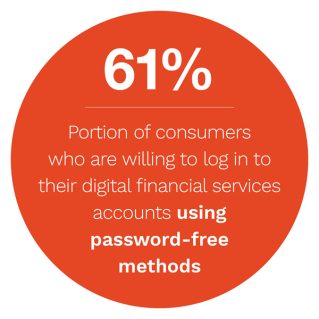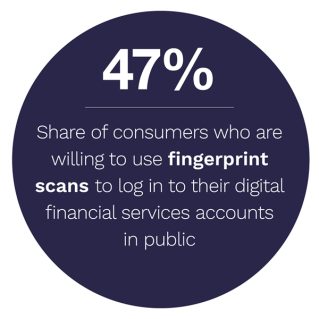The increased global penetration of mobile devices has transformed how consumers transact with their preferred financial institutions (FIs), merchants and service providers. As consumers’ lives have become more digitally connected, positively verifying end users’ identities is now especially important. Many financial services providers, however, still rely on password authentication as a primary method for their customers to access accounts and personal data. Stolen usernames and passwords thus remain a primary threat vector for cybercriminals who can engage in identity theft and fraud often before breaches are detected.
PYMNTS research finds that consumers use digital banking to access their accounts across multiple digital platforms, including mobile apps and mobile- and desktop-based browsers, but 64% of them use a username and password combinations to access their accounts. Consumers have high expectations for digital banking experiences that are both convenient and secure and, as a result, are increasingly interested in stronger forms of authentication, such as biometric fingerprint, face and voice scans.
These are among the surprising findings to emerge from The Future Of Authentication In Financial Services, a PYMNTS and Entersekt collaboration. In this edition, Using Authentication To Build Trust, we examine consumers’ preferences for different authentication methods when accessing financial services providers. The report draws on insights from a survey of 2,719 consumers from Sept. 10 through Sept. 27, 2021.

More key findings from the study include:
Six out of 10 consumers are willing to try login methods other than passwords.
This share rises to 73% for those who use multiple devices to access their accounts. Sixty-one percent of consumers are willing to log in to their accounts with alternative authentication methods, and 60% of those who use mobile apps and mobile- and desktop-based browsers say they would be “very” comfortable logging in using methods other than login IDs and passwords. Nearly half of these users believe passwords will eventually be phased out as an authentication method.
More than one-third of consumers are willing to use biometric methods for authentication purposes.
Forty-nine percent of consumers say they are “slightly” or “not at all” reluctant to use fingerprint scans in private settings, while 47% say the same about using them in public. Also, 44% of consumers say they are “slightly” or “not at all” reluctant to use facial scans in private, and 41% report feeling the same about using them in public. Similarly, 43% of consumers are “slightly” or “not at all” reluctant to use voice scans in private settings, while only 37% say the same about using them in public.
Nearly two-thirds of consumers say that an emphasis on data security has a “very” or “extremely” big impact on their trust in a financial services provider.
Sixty percent say that having information about how their transactions are secured has a “very” or “extremely” big impact on their trust in financial services providers. Forty-four percent of consumers say that the ability to log in without passwords is “very” or “extremely” impactful on their trust and 32% report this has a “moderate” impact.
To learn more about consumers’ preferences for different authentication methods when accessing financial services providers, download the report.

